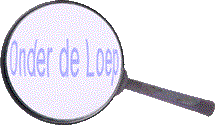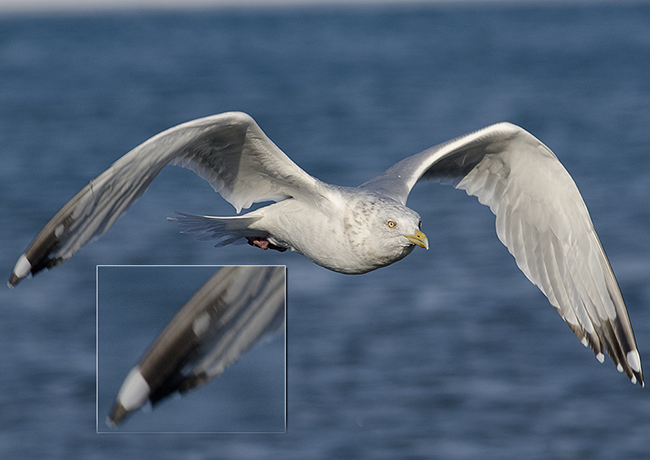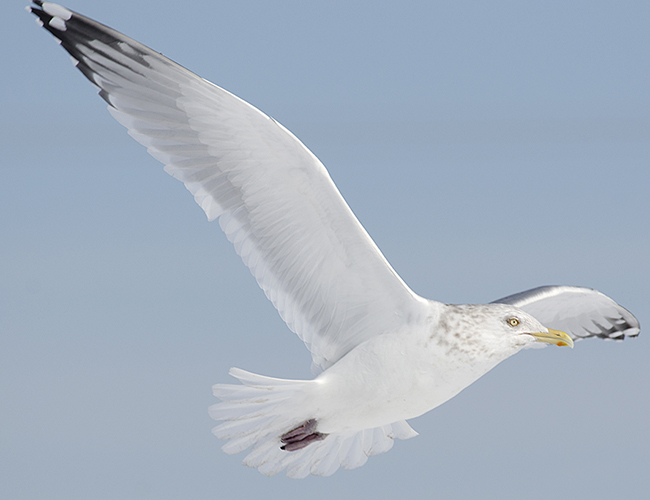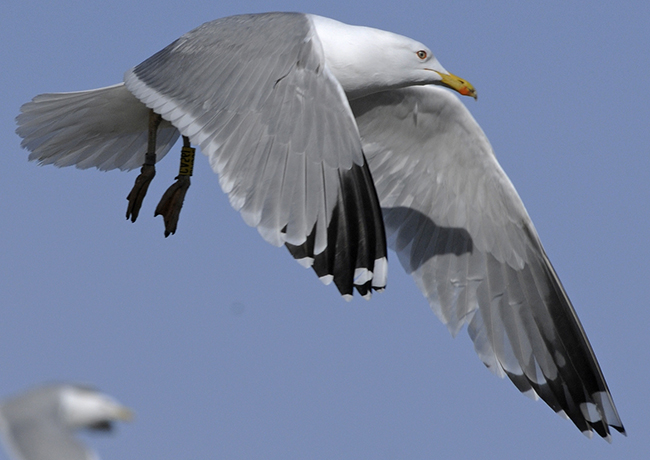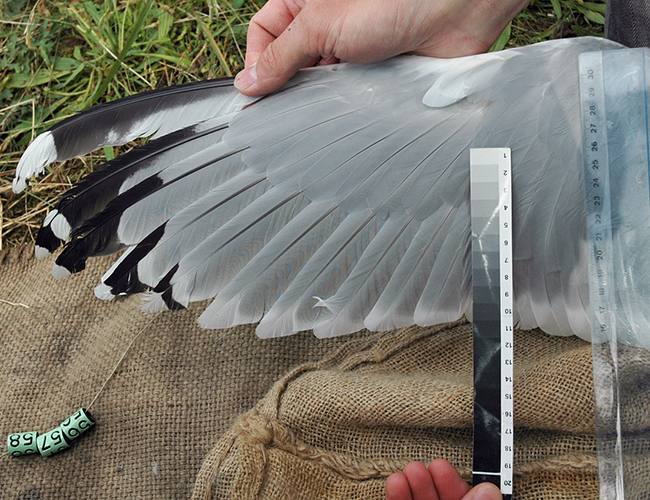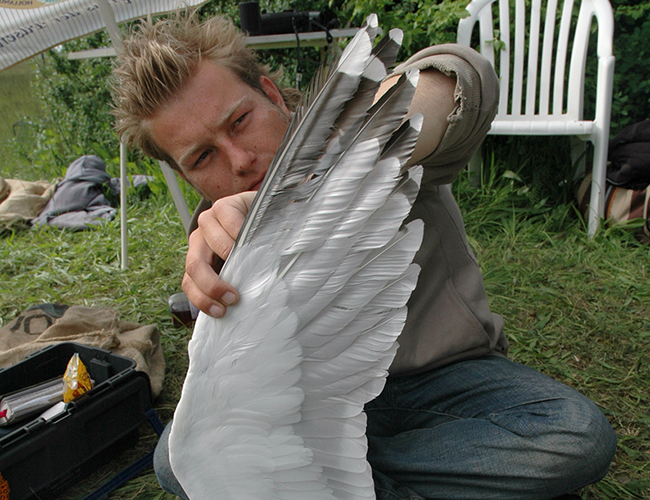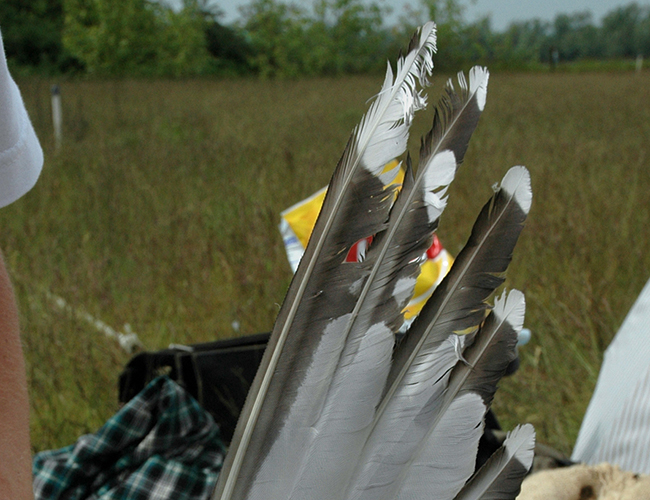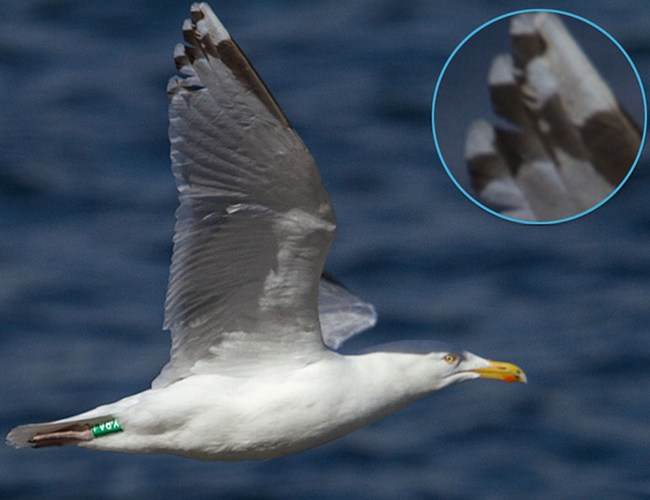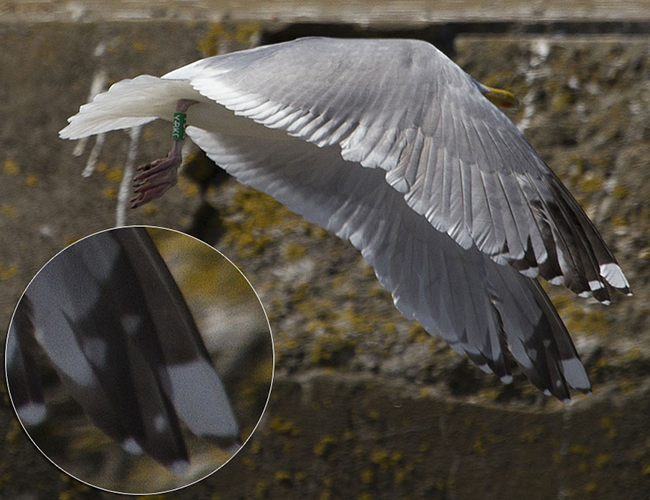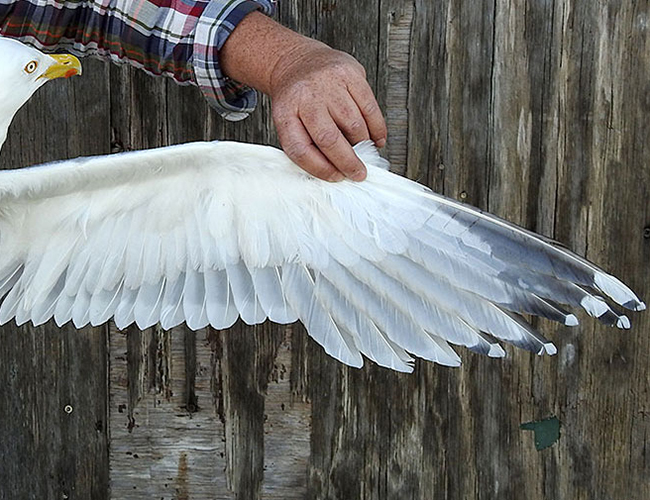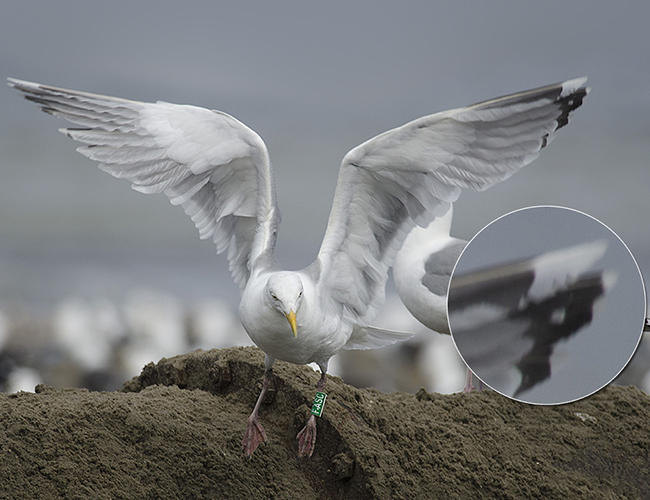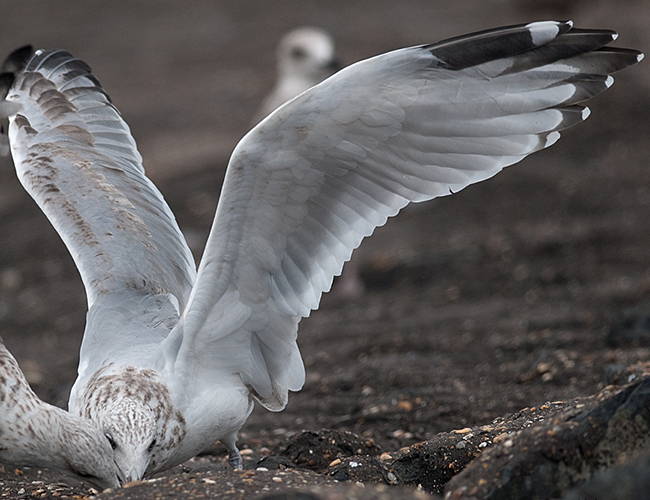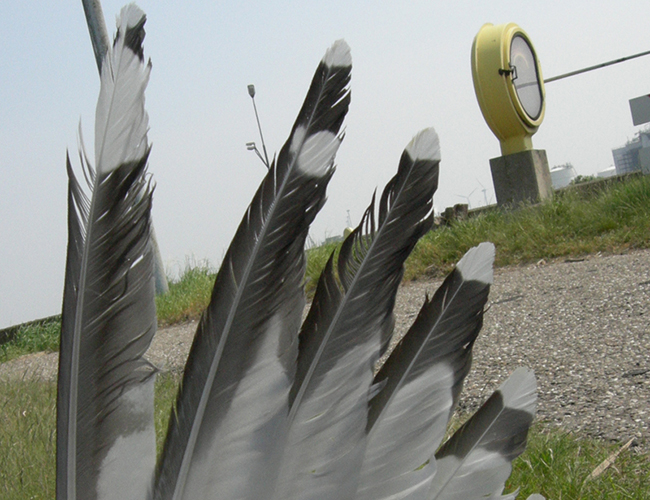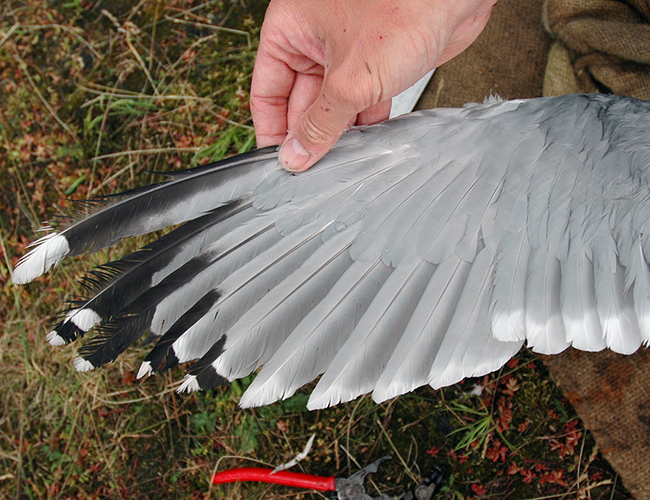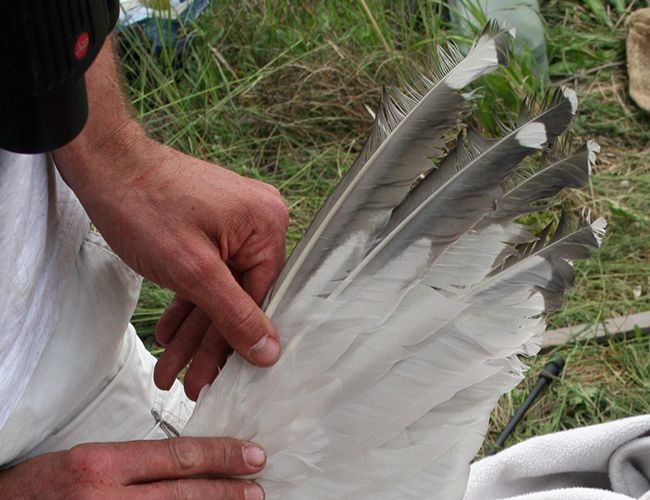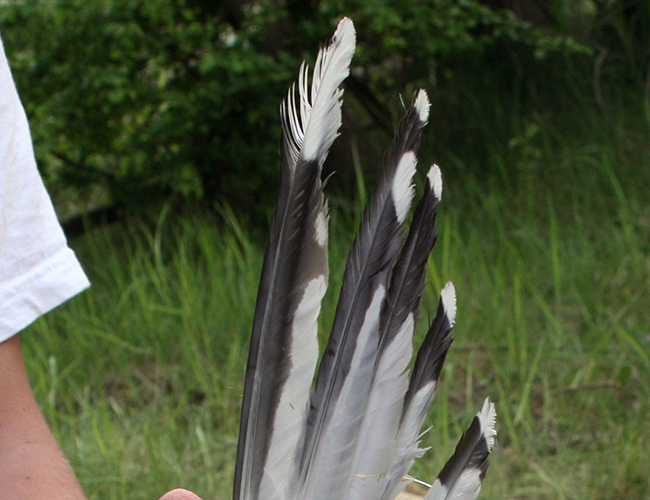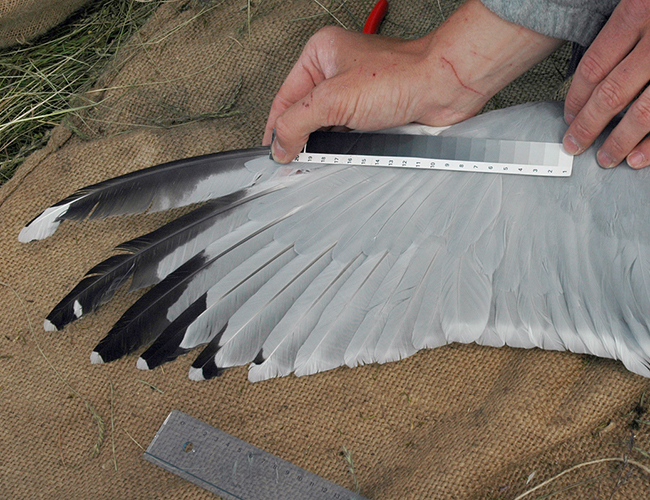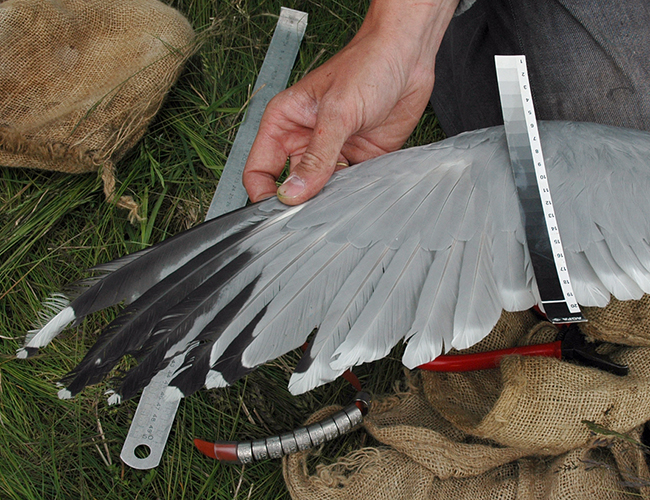Using pseudo-mirrors as an identification feature for adult Herring Gulls

Maarten van Kleinwee & Mars Muusse, January 2018
When it comes to identifying American Herring Gulls (Larus smithsonianus) in Europe, most attention is given to the primary pattern on the upper wing, as described by Peter Adriaens & Bruce Mactavish in the paper "Identification of adult American Herring Gull" (Dutch Birding 26: 151-179, 2004). Most distinctive and well known is the 'W'-shaped black band on P5, but other features such as a lack of a mirror on P9 and 'bajonet' shapes on the outer webs of the outer primaries also need to be present for clinching the identification and eliminate the possible European herring Gull. When it comes to features on the underwing, the rather long and squarish tongue on P10 is referred to.
But there are other features that can be found on the underwing which are much less known, but helpful in identifying American Herring Gulls: the 'pseudo-mirror' and its equivalent the 'grey cut'.
- The pseudo-mirror appears as a small, whitish area located in the black section in the inner web of the feather, and is fully surrounded (isolated) by the black. It varies in shape and size.
- The grey cut is very similar to the pseudo-mirror, but instead of being fully surrounded, it is located along the feather edge and therefore open on one side (not isolated). The grey cut too is located in the inner web and also varies in shape and size.
 |
| Plate 1: An example of grey cuts in the inner web of P10 (left) and pseudo-mirrors in the inner web of P9 (right). |
Note that the difference between the two is not always clear, as we will see in examples later in the article. First, here are a few adult American Herring Gulls showing pseudo-mirror and/or the grey cut.
Can we safely assume these identification features are uniqe for American Herring Gull?
April 2013, Peter Adriaens published an article on Birdingfrontiers.com, in which he suggested that the pseudo-mirror can be found regular in American Herring Gull and should be considered very rare in European Herring Gulls. Therefore, when it comes to identification of American Herring Gull in a Europen context, it may be an important indication. Peter stated that a pseudo-mirror "is rare in European Herring Gulls, perhaps mainly occurring in birds with medium to dark grey upperparts (i.e. slightly darker than American Herring Gull)". This article raised the interest in European gull lovers and made them look more closely at their local Herring Gulls to score any presence or absence of this new ID feature.
British Herring Gull argenteus
Both Maarten and Mars have a large collection of images of breeding birds, both Herring Gull argenteus and Lesser Black-backed Gull graellsii, photographed in colonies of Moerdijk and IJmuiden Forteiland respectively. Many of these individuals have been photographed in the hand, showing feather details of the open wing. When checking the images of breeding birds, trapped on the nest in the Netherlands, the features of pseudo-mirror and grey cut were also found in several Herring Gulls of the taxon argenteus. Herring gull argenteus is about equal in upperpart grey tone (Kodak 4-6) as is American Herring Gull smithsonianus. Below are several of the more prominent Dutch example birds (for some images, click to get larger size):
Are pseudo-mirrors really rare in Herring Gulls in Europe?
As the above examples show, pseudo-mirrors and grey cuts are more common in British and Scandinavian Herring Gulls than previously thought. Why is it then that these have gone unnoticed so much? Probably the answer is twofold. A: no one searched for this particular pattern in the wingtip of Herring gulls. B: the variation of patterns seems (and is) huge in this commom species. Furthermore, individual birds may show variation in their primary pattern over multiple seasons, showing slight changes in the amount of black pigmentation. To complicate it further, differences even exist between the left wing and the right wing.
Such variation in the primary pattern was already mentioned in "Phenotypic characteristics and moult commencement in breeding Dutch Herring Gulls" (Seabird, 2011): "Furthermore, the pattern on P9 and P10 may vary from year to year in both Herring and Lesser Black-backed Gull, with single birds of both taxa even showing more black in 2006 than they did in 2005. Finally, there may also be differences between patterns on the right and left wing, but we did not record this.".
This was further confirmed in recent research (2018) by Maarten van Kleinwee, based on observations of colour-ringed European Herring Gulls in the breeding colony of IJmuiden Forteiland, the Netherlands, over various seasons. Various examples were found of individual birds that showed pseudo-mirrors or grey cuts one year (moult cycle), but not in another year. Differences between the wings of an individual were also recorded.
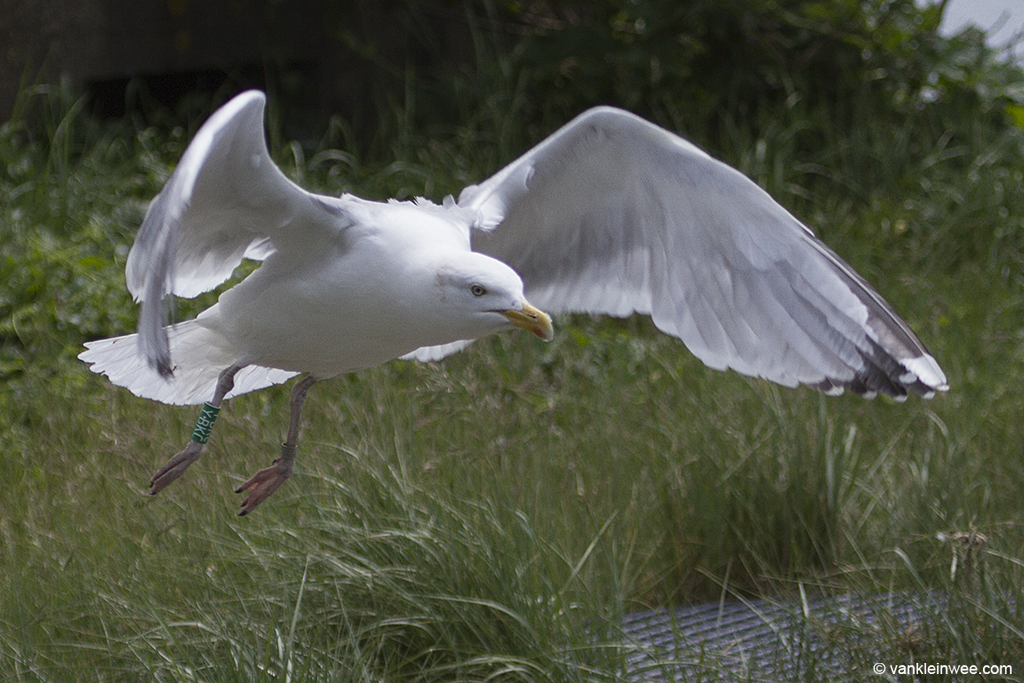 |
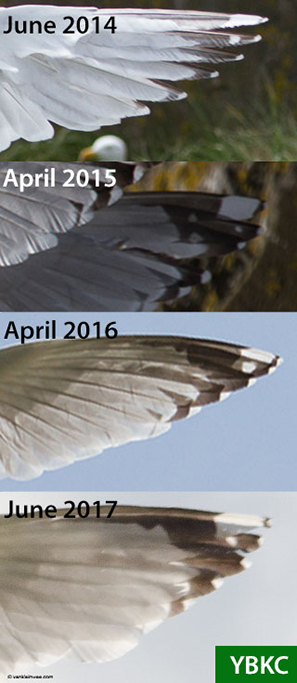 |
| Plate 23-24: Herring Gull (argenteus) YBKC adult, June 2014, IJmuiden, the Netherlands. Picture: Maarten van Kleinwee. |
|
For more examples, see the article on Gulls to the Horizon: Status update on the presence of pseudo-mirrors and non-isolated mirrors in IJmuiden-ringed adult European Herring Gulls.
The individual variation of wingtip patterns, together with individual birds showing seasonal variation over multiple seasons, and the potential differences between the left wing and the right wing will pretty much hamper finding individuals with pseudo-mirrors or with a grey cut. A quanitifying estimation for these features to be present in either (sub-)species therefore can perhaps only be safely done by following a group of known (ringed) individuals over multiple seasons. Prior to this, it seems wise to first agree on what we mean by 'pseudo-mirror' and 'grey cut' (minimal size of the spot?, completely enclosed spot?, colour tone of the spot?, etc).
Other species
Pseudo-mirror and grey cut are commonly found in American Herring Gull, and we have illustrated with several example birds that it also occur in adult Scandinavian and British Herring Gulls. And it seems a feature mainly seen in large gulls, and predominantly in adult Herring Gulls. However, there may have been little reason to check other taxa on this characteristic pattern, as other taxa hardly resemble American Herring Gull, for which species it was descibed originally. We quickly check other (large) gull species and came accross a limited number of birds showing the pseudo-mirror. Again, this could be related to the fact that such features are only shown in specific moult cycles for any particular individual bird. Below are some examples, one Lesser Black-backed Gull and several Caspian Gulls (many thanks to Łukasz Bednarz and his ringing team for sending images).
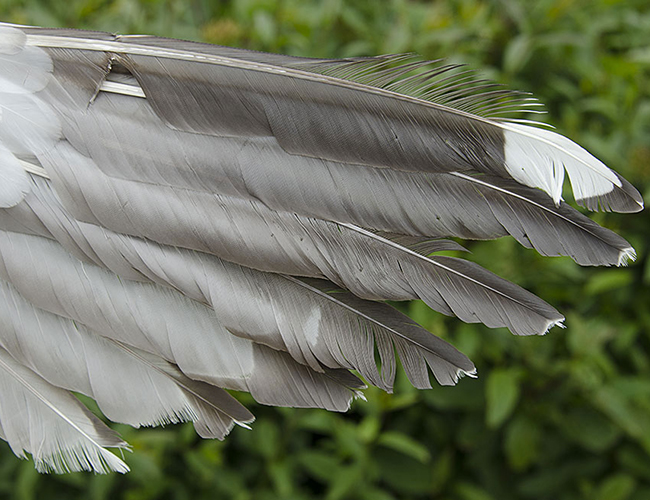 |
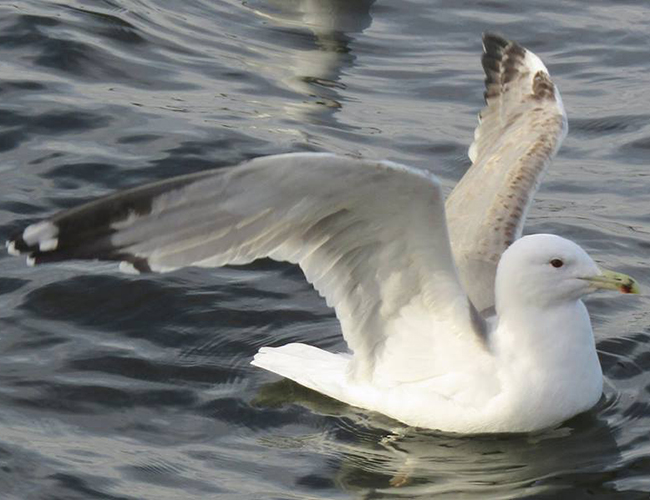 |
| Plate 25: Lesser Black-backed Gull (graellsii) SAAL adult, May 2015, Zaandam, the Netherlands. Picture: Maarten van Kleinwee. Showing a pseudo-mirror on the under side of P7 in the left wing. |
Plate 26: Caspian Gull (cachinnans) VCPE 4CY, January 2018, Copenhagen, Denmark. Picture: René Rantzau. Showing a grey cut on the under side of P10. |
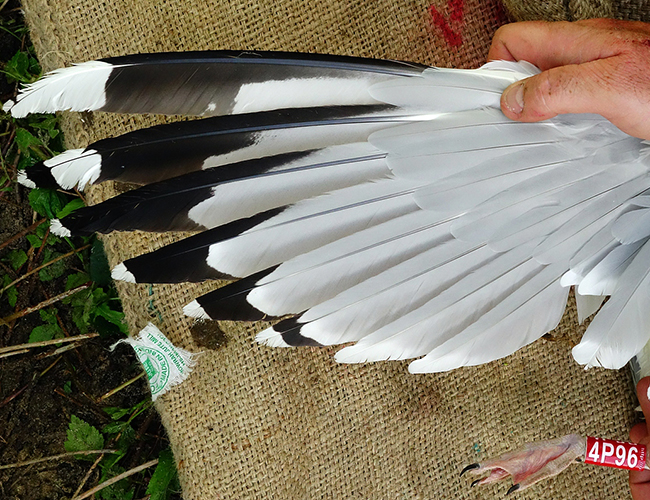 |
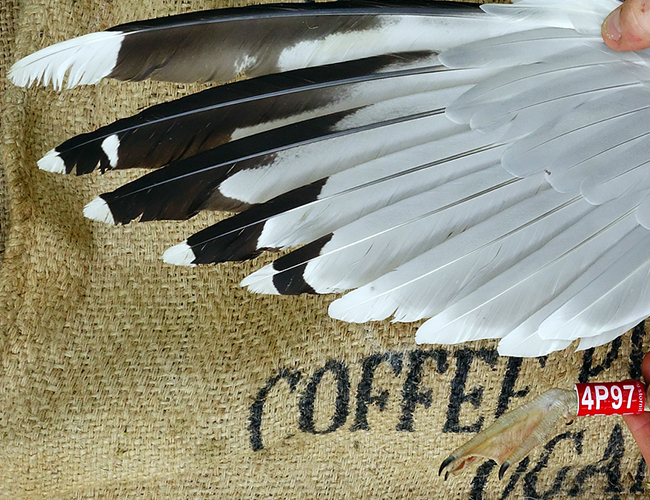 |
| Plate 27: Caspian Gull (cachinnans) 4P96 adult, May 2014, Zastów Karczmiski, Poland. Picture: Łukasz Bednarz ringing team. Showing a pseudo-mirror on P10 in the left wing. | Plate 28: Caspian Gull (cachinnans) 4P97 adult, May 2014, Zastów Karczmiski, Poland. Picture: Łukasz Bednarz ringing team. Showing an indistinct pseudo-mirror on P10 in the left wing. |
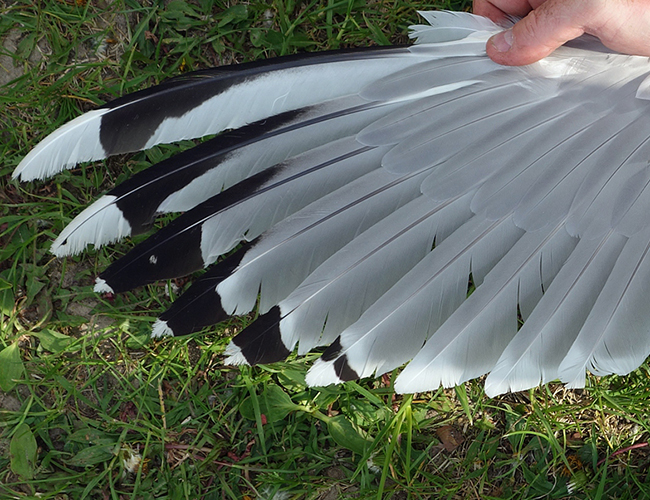 |
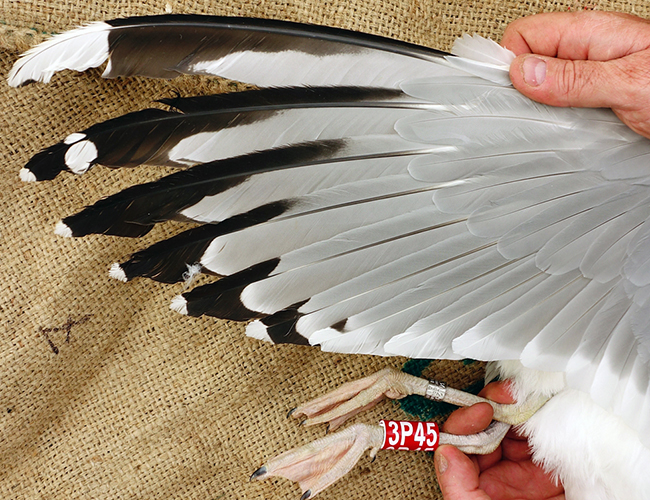 |
| Plate 29: Caspian Gull (cachinnans) 1P29 adult, May 2013, Wytyckie Lake - Urszulin, Poland. Picture: Łukasz Bednarz ringing team. Showing a mirror / pseudo-mirror on P8 in the left wing. | Plate 30: Caspian Gull (cachinnans) 3P45 adult, April 2014, Wytyckie Lake - Urszulin, Poland. Picture: Łukasz Bednarz ringing team. Showing a tiny pseudo-mirror on P10 in the left wing. |
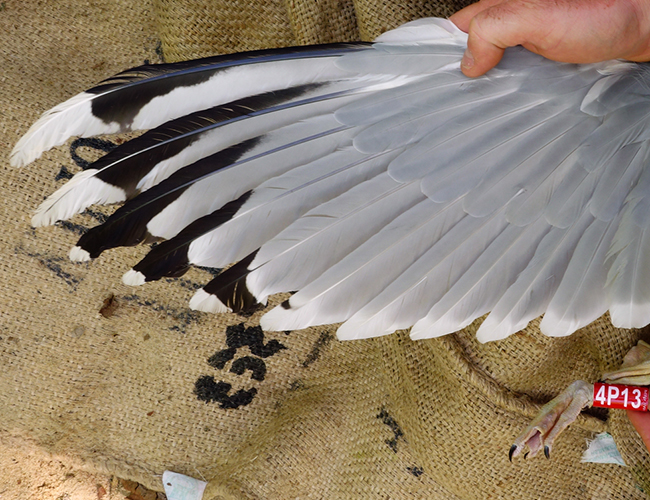 |
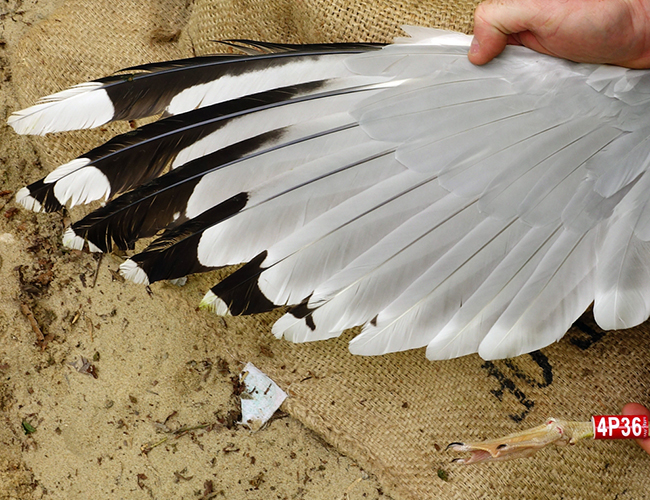 |
| Plate 31: Caspian Gull (cachinnans) 4P13 adult, May 2014, Zastów Karczmiski, Poland. Picture: Łukasz Bednarz ringing team. Showing a small pseudo-mirror on P10 in the left wing. | Plate 32: Caspian Gull (cachinnans) 4P36 adult, May 2014, Zastów Karczmiski, Poland. Picture: Łukasz Bednarz ringing team. Showing a pseudo-mirror on P8 in the left wing. |
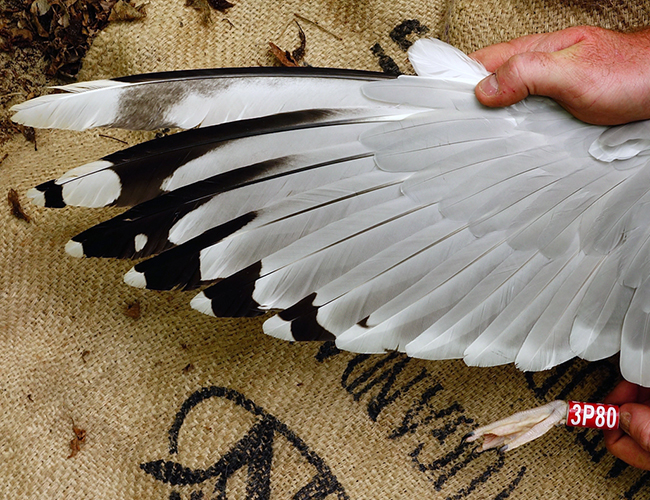 |
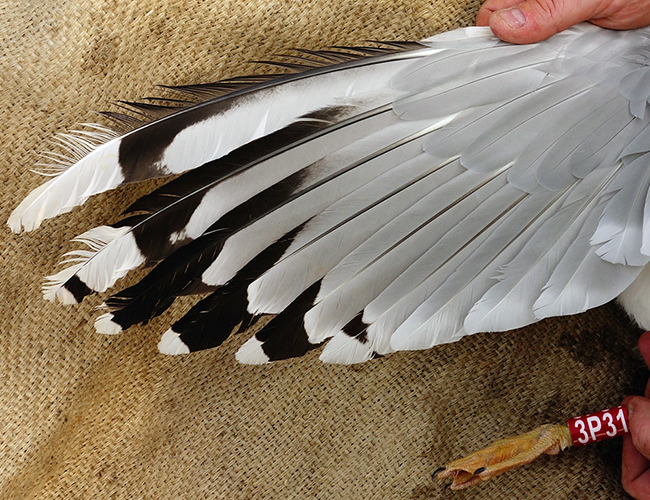 |
| Plate 33: Caspian Gull (cachinnans) 3P80 adult, May 2014, Zastów Karczmiski, Poland. Picture: Łukasz Bednarz ringing team. Showing a mirror / pseudo-mirror on P8 in the left wing. | Plate 34: Caspian Gull (cachinnans) 3P31 adult, April 2014, Wytyckie Lake - Urszulin, Poland. Picture: Łukasz Bednarz ringing team. Showing a pseudo-mirror on P9 in the left wing, depending on whether this spot is interpreted as fully closed. |
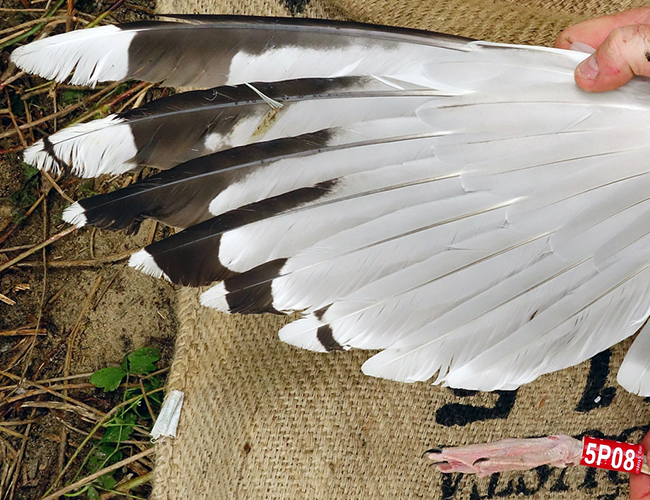 |
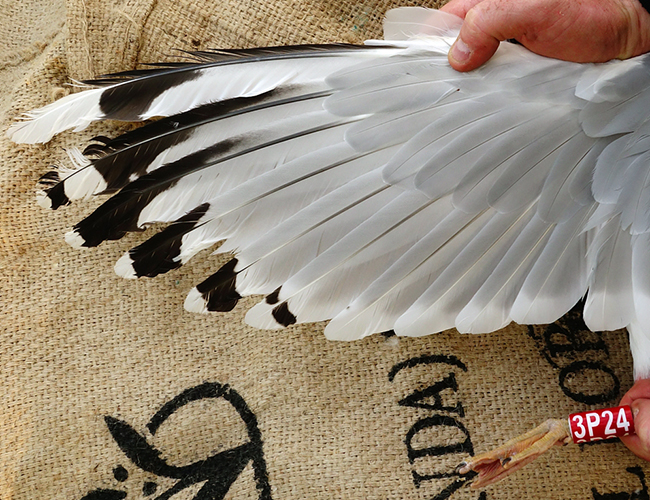 |
| Plate 35: Caspian Gull (cachinnans) 5P08 adult, May 2014, Zastów Karczmiski, Poland. Picture: Łukasz Bednarz ringing team. Showing a pseudo-mirror on P9 in the left wing, depending on whether this spot is interpreted as fully closed. | Plate 36: Caspian Gull (cachinnans) 3P24 adult, April 2014, Wytyckie Lake - Urszulin, Poland. Picture: Łukasz Bednarz ringing team. Showing a pseudo-mirror / grey cut on P9 in the left wing. |
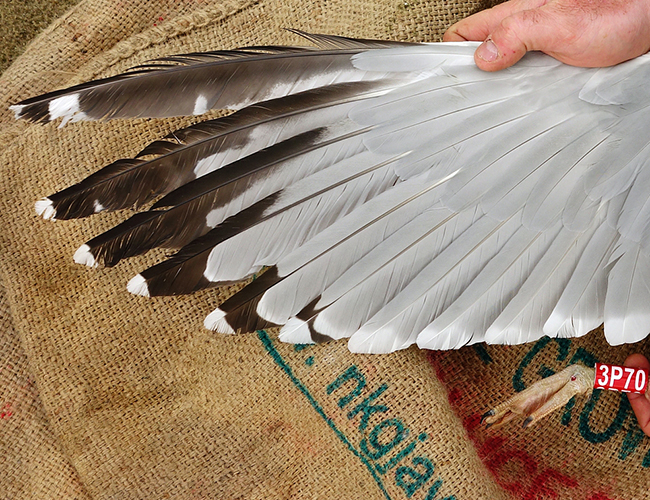 |
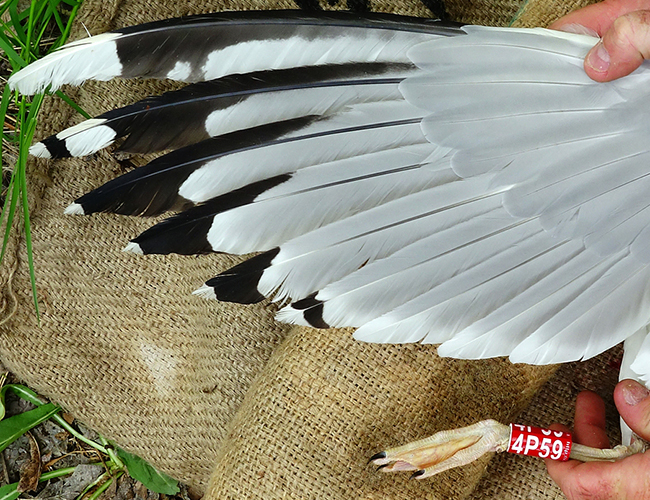 |
| Plate 37: Caspian Gull (cachinnans) 3P70 adult, May 2014, Zastów Karczmiski, Poland. Picture: Łukasz Bednarz ringing team. Showing a grey cut on P10 in the left wing. | Plate 38: Caspian Gull (cachinnans) 4P59 adult, May 2014, Zastów Karczmiski, Poland. Picture: Łukasz Bednarz ringing team. Showing a grey cut on P10 in the left wing. |
Conclusion
The presence of a pseudo-mirror in American Herring Gull was descibed by Peter Adriaens as a good new feature to look at, if one scans flocks of European gulls to find an out-of-range smithsonianus. Only rarely would European Herring gulls show this pseudo-mirror, and if present, than more commonly in Scandinavian argentatus (which pose no real ID problem as the upperparts are much darker in argentatus than they are in smithsonianus).
After checking the database of images of breeding birds in the Netherlands, we conclude that this pseudo-mirror may occur as well in our breeding population of Herring Gull argenteus (which are about equally pale grey on the deck as smithsonianus).
We emphasize it's important to be very precise in one's definition of 'pseudo-mirror' for the individual variation of wingtip patterns is huge and in several birds we discussed whether a pale spot should be interpretted as 'fully closed'. For spots at the edge of a feather we introduced the term "grey cut".
Two other issues are: individual birds that show wingtip variation over multiple seasons, and the potential differences between the left wing and the right wing.
For a quanitifying estimation of the present of pseudo-mirrors we suggest to follow ringed individuals over multiple seasons.
References
A new feature for identifying adult American Herring Gull (Birdingfrontiers.com, 2013)
Phenotypic characteristics and moult commencement in breeding Dutch Herring Gulls (Seabird, 2011)
Status update on the presence of pseudo-mirrors and non-isolated mirrors in IJmuiden-ringed adult European Herring Gulls (Gulls to the Horizon, 2018)
Identification of American Herring Gull in a western European context (Dutch Birding 26: 1-35, 2004)
Identification of adult American Herring Gull (Dutch Birding 26: 151-179, 2004)
Many thanks to Fred Cottaar and to Roland-Jan Buijs for participation in their research projects and many thanks to Łukasz Bednarz for sending images of Polish breeding birds.

